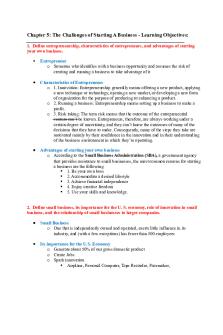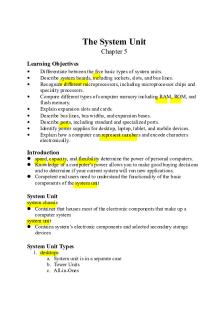Chapter 5 Notes PDF

| Title | Chapter 5 Notes |
|---|---|
| Author | Jasmine Martinez |
| Course | Organizational Communication |
| Institution | Central Michigan University |
| Pages | 2 |
| File Size | 73.2 KB |
| File Type | |
| Total Downloads | 108 |
| Total Views | 152 |
Summary
Org. Com Notes Ch 5...
Description
Constitutive Approach Constitutive ● Making a thing what it is; essential Origins ● In 1990’s scholars began to object to the idea of the org. As a container in which communication occurs (container metaphor) ● In the late 20th century, western culture moved from a condition of modernity (the modern era) to a condition of postmodernity (the postmodern era) Influence on Org Comm Scholarship ● Interest in studying organizing rather than organizations ● Emergence of a school of thought called the communicative constitution of organizations, or CCO ○ Tries to understand how human interactions create, recreate and change organizations ○ Based on social constructionism, interested in “little d” and “big D” discourse ○ Two major examples: The Montreal School, The Four Flows CCO - Foundational Ideas Social constructionism - argues that reality is not an objective thing but and intersubjective construction created through communication ● Social world made up of structures, but humans also have agency about how to respond to those structures. (Giddens) ● Structures both constrain and enable our behavior. ○ Term to describe this: duality of structure How do we ‘trace’ the communication? Scholars look at two kinds of discourse, distinguished by lower-case d and capital D Discourse - “general enduring systems of thought”: communication about concepts or terms that come to carry a special meaning Two Schools of Thought for Explaining the Organizing Process 1. The Montreal School - interested in the agency of texts and how discourse can be “scaled up” to have greater shared meaning and influence 2. The Four Flows - a model that depicts four simultaneous, ongoing arenas of organizing through discourse The Montreal School Organizing happens) organization emerges as little-d discourse “scales up” into influential texts through a sequence of six degrees of separation 1. Degree - two hackers talking about taking on a “hacktivist” project 2. Degree - they start to tell other people about their idea (now as a narrative) through one-
on-one conversations 3. Degree - two hackers develop a plan 4. Degree - the hackers begin using shorthand ways of referring to the project and other people become involved who understand these terms. 5. Degree - these conversations become “material” as the hackers start writing code (or developing other tangible elements) for their project 6. Degree - their way of organizing the hacktivist project become a template for another Anonymous projects to use The Four Flows Goal of this model: To identify the functions of communication flows in constituting organizations 1. Membership negotiation - who are members (now), and how can you tell? 2. Self structuring - what are norms, standards and rules for getting work done? 3. Activity coordination - what activities are being accomplished and how? 4. Institutional positioning - what relationships does the entity have with other entities in its environment? How do resources flow between them? Critiques of the Constitutive Approaches 1. Overemphasis on socially constructed ‘reality’ - overlooks material reality? Materiality - concerns with objects such as buildings or furniture, the bodies we inhabit, etc. 2. Focuses on microscopic interactional processes - overlooks issues of power and control...
Similar Free PDFs

Chapter 5 - Lecture notes 5
- 15 Pages

Chapter-5 - Lecture notes 5
- 6 Pages

Chapter 5 - Lecture notes 5
- 83 Pages

Chapter 5 - Lecture notes 5
- 4 Pages

Chapter 5 - Lecture notes 5
- 20 Pages

Chapter 5 - Lecture notes 5
- 4 Pages

Chapter 5 - Lecture notes 5
- 7 Pages

Chapter 5 - Lecture notes 5
- 2 Pages

Chapter 5 - Lecture notes 5
- 3 Pages

Chapter 5 - Lecture notes 5
- 2 Pages

Chapter 5 - Lecture notes 5
- 6 Pages

Chapter 5 - Lecture notes 5
- 6 Pages

Chapter+5 - notes for chapter 5
- 8 Pages

Chapter 5 Notes 4e
- 12 Pages

Chapter 5 Notes
- 15 Pages

Chapter notes 1-5
- 72 Pages
Popular Institutions
- Tinajero National High School - Annex
- Politeknik Caltex Riau
- Yokohama City University
- SGT University
- University of Al-Qadisiyah
- Divine Word College of Vigan
- Techniek College Rotterdam
- Universidade de Santiago
- Universiti Teknologi MARA Cawangan Johor Kampus Pasir Gudang
- Poltekkes Kemenkes Yogyakarta
- Baguio City National High School
- Colegio san marcos
- preparatoria uno
- Centro de Bachillerato Tecnológico Industrial y de Servicios No. 107
- Dalian Maritime University
- Quang Trung Secondary School
- Colegio Tecnológico en Informática
- Corporación Regional de Educación Superior
- Grupo CEDVA
- Dar Al Uloom University
- Centro de Estudios Preuniversitarios de la Universidad Nacional de Ingeniería
- 上智大学
- Aakash International School, Nuna Majara
- San Felipe Neri Catholic School
- Kang Chiao International School - New Taipei City
- Misamis Occidental National High School
- Institución Educativa Escuela Normal Juan Ladrilleros
- Kolehiyo ng Pantukan
- Batanes State College
- Instituto Continental
- Sekolah Menengah Kejuruan Kesehatan Kaltara (Tarakan)
- Colegio de La Inmaculada Concepcion - Cebu